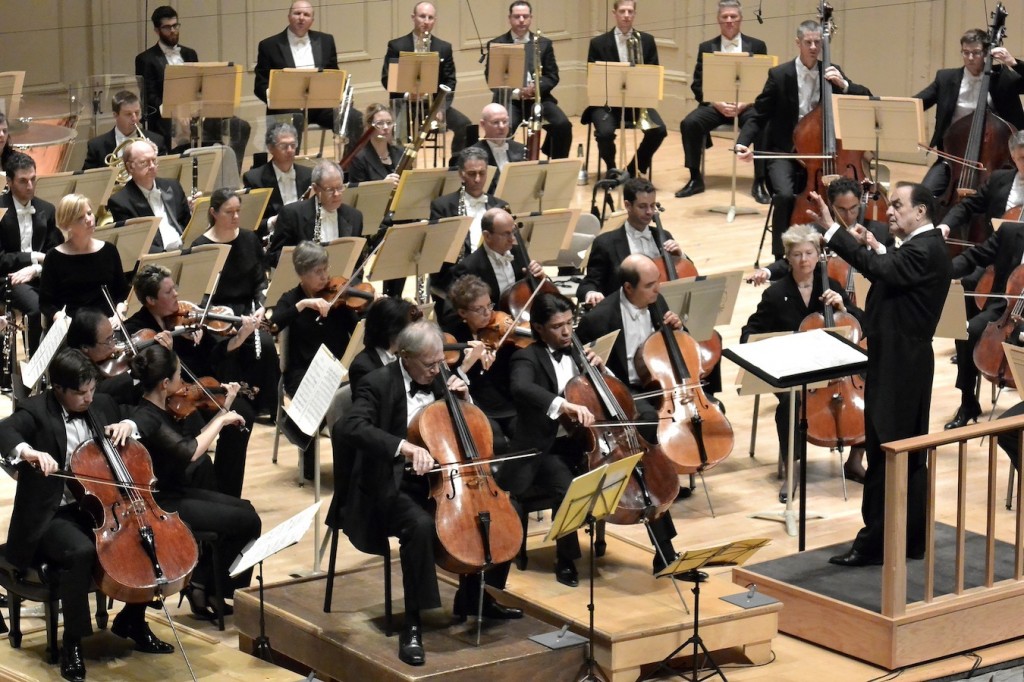Dutoit, BSO mark Penderecki’s 80th with his triple-cello showpiece

Charles Dutoit leads the BSO and soloists Arto Noras, Gautier Capuçon, and Daniel Müller-Schott in Penderecki’s Concerto Grosso No. 1 for Three Cellos Thursday night at Symphony Hall. Photo: Stu Rosner
Krzysztof Penderecki turns 80 this month, and, as one of many birthday celebrations around the globe, the Boston Symphony Orchestra presented the composer’s Concerto Grosso No. 1 for Three Cellos and Orchestra Thursday night at Symphony Hall.
This is the first time the BSO has performed the work, and it was fitting that its dedicatee, Charles Dutoit, who conducted the world premiere in 2001, returned to Boston to lead the way.
Cast in six movements that are played without pause, the Concerto Grosso is a kaleidoscope of styles and orchestral color. Though the title suggests a Baroque model, the work has the size and scope of its more expansive nineteenth-century counterparts. Both haunting and thrilling, the concerto’s dark, dissonant lines and organic form make it one of Penderecki’s most supremely well-crafted scores.
The work opens with jagged rhythms in the strings sounding over murmurs in the basses. Angular lines grow from this earthy sonority, spreading wildly as they spin about in the ever-changing texture. The BSO brass section, with hulking chords, added weight. Elsewhere, pockets of instruments supplied eerie, even humorous effects.
Single notes pulsed relentlessly from the violins, and the contrabassoon and tuba growled together in heavy, bloated phrases. At its climax, the music thundered with drum rolls and stabbing figures in the low strings, like an army marching to war.
The trio of cello soloists, Arto Noras, Gautier Capuçon, and Daniel Müller-Schott, moved between recitative-like passages and more aggressive patterns, interchanging their lines with each other and the ensemble with authority.
Penderecki’s concerto showcases the cellists as distinct personalities in ongoing dialogue. Capuçon played with silvery tone, Müller-Schott with a round, plummy sound. Noras, sitting between them, answered with rich, singing phrases. Each adjusted their playing to suit the concertos’s unfolding narrative, at times, adding a slight edge to their tones. For the austere ending, the cellists returned to the work’s opening recitatives, each voice sounding out as if in a vast wilderness.
Ravel’s Le Tombeau de Couperin, a similar marvel of orchestral color, opened the concert.
Originally a series of six piano pieces, the composer took four of those–Prelude, Forlane, Menuet, and Rigaudon–as the basis for his orchestral version. While outwardly neo-Baroque in style, the work is a showpiece for the orchestra, filled with florid lines, percolating rhythms, and warm inner textures that coalesce in simmering waves of sound.
The orchestra was at their finest in this French delicacy, and the performance glistened with especially fine woodwind playing. Sweet oboe and flute melodies melded in the Menuet, and, in the final movement, the oboe and English horn finished each other’s lines with grace.
Dutoit, with light waving gestures, at times appeared less a conductor than a choreographer, coaxing streams of music from the ensemble.
To close, he led a commanding reading of Edward Elgar’s Enigma Variations, its beefy, sonorous scoring a welcome counterweight to the other works offered earlier in the evening.
The fourteen variations of Elgar’s best-known work are miniature portraits of the composer’s friends. The wide-ranging music contains moments of passion and warmth as well as fairy-like elegance. Other sections bear the splendor that would characterize his popular Pomp and Circumstance Marches.
The work’s Edwardian swagger proved eminently well suited to the luster of the BSO. The ensemble swelled to a sound of Wagnerian proportions in the thundering dance of the seventh variation amnd the musicians offered a grand reading of the famous “Nimrod.” Walls of brass chords added power to the heroic finale, a variation depicting Elgar himself.
The program repeats 1:30 p.m. Friday and at 8 p.m. Saturday and Tuesday at Symphony Hall. bso.org; 617-266-1492
Posted in Performances




